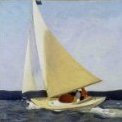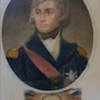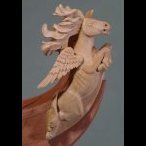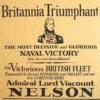-
Posts
8,149 -
Joined
-
Last visited
Reputation Activity
-
 allanyed got a reaction from Sandman in HMS Victory by monello - Scale 1:38 - First wooden ship build
allanyed got a reaction from Sandman in HMS Victory by monello - Scale 1:38 - First wooden ship build
Monello,
I assume you know of all the plans available at NMM, many of which can be found on their web site. Details abound! http://collections.rmg.co.uk/collections/objects/79916.html is but one example from 1765.
Now, start making some saw dust!
Allan
-
 allanyed got a reaction from mtaylor in HMS Victory by monello - Scale 1:38 - First wooden ship build
allanyed got a reaction from mtaylor in HMS Victory by monello - Scale 1:38 - First wooden ship build
Monello,
I assume you know of all the plans available at NMM, many of which can be found on their web site. Details abound! http://collections.rmg.co.uk/collections/objects/79916.html is but one example from 1765.
Now, start making some saw dust!
Allan
-
 allanyed got a reaction from monello in HMS Victory by monello - Scale 1:38 - First wooden ship build
allanyed got a reaction from monello in HMS Victory by monello - Scale 1:38 - First wooden ship build
Monello,
I assume you know of all the plans available at NMM, many of which can be found on their web site. Details abound! http://collections.rmg.co.uk/collections/objects/79916.html is but one example from 1765.
Now, start making some saw dust!
Allan
-
 allanyed got a reaction from monello in HMS Victory by monello - Scale 1:38 - First wooden ship build
allanyed got a reaction from monello in HMS Victory by monello - Scale 1:38 - First wooden ship build
Monello,
One does not have to start small, nor with a kit. I believe you can do it. About 1976-1982 I built Victory and actually sold it, then built it again. Both were scratch and my first completed models so I know you can do it. (They were NOT as big your model will be)
I look forward to following your build log.
Allan
-
 allanyed got a reaction from clipper in HMS Vulture 1776 by Dan Vadas - FINISHED - 1:48 scale - 16-gun Swan-class sloop from TFFM plans
allanyed got a reaction from clipper in HMS Vulture 1776 by Dan Vadas - FINISHED - 1:48 scale - 16-gun Swan-class sloop from TFFM plans
Danny
While the very very high quality of your work is obvious, your step by step series of photos is terrific and a great help to anyone that has not yet put together a bow from scratch. Making and fitting these parts is truly a challenge, but you have shown in a very clear way that it is a matter of patience more than anything else.
Allan
-
 allanyed got a reaction from Jeronimo in LE BONHOMME RICHARD by Jeronimo - FINISHED
allanyed got a reaction from Jeronimo in LE BONHOMME RICHARD by Jeronimo - FINISHED
Bravo on what is the best cross section build I have seen in a long long time.
Allan
-
 allanyed got a reaction from NenadM in Stanchions on Cutty Sark
allanyed got a reaction from NenadM in Stanchions on Cutty Sark
Clearways
The stations are round so I don't think etching would work. Some brass rod of various diameters and a bit of silver soldering is all that is needed to make them. They are painted white based on the photo posted by Nenad so no blackening of the brass is required. Just a bit of cleaning before painting. If you are not experienced in silver soldering, fear not ! The thought of silver soldering was rather intimidating to me before I gave it a try. Once I made a few soldered joints I was hooked and never again used CA, soft solder or epoxy for joining brass.
Allan
-
 allanyed got a reaction from captainbob in Poplar wood for modelling
allanyed got a reaction from captainbob in Poplar wood for modelling
Rob,
The Janka Scale hardness for Tulep is 540 where as the poplar that we commonly see in the US is 500 and bass is 380 for a comparison. English box is 2840 and Holly is 1080. Best way to find out if it can be used is to try a few pieces and see how you like working with it.
Allan
-
 allanyed got a reaction from hamilton in trunnels on margin planks?
allanyed got a reaction from hamilton in trunnels on margin planks?
Hamilton,
What scale is your Fair Rosamund? Trennals (trunnels, treenails, trenails, tomato, tomahto) for the deck planks were relatively small. In addition, they were often seated below the surface of the deck planks then capped with a wooden cover piece so the end grain of the trennal was not exposed.
If you are at 1/4 scale and you want to use and show treenails, go for it. They were probably no more than an inch diameter or less. The smallest hole on my Byrnes draw plate is needed to get this small. Not an easy task, even using bamboo.
If I was building at 1/8 scale, I would not show them as I have no way of making them small enough. 3/16 is a close call but doable (look at Ed Tosti's Naiad build log for evidence.) IMHO, out of scale trunnels and hatch gratings are the easiest way to ruin the look of an otherwise fine model.
Allan
-
 allanyed got a reaction from Jay 1 in New Scantling book announced by Seawatch books
allanyed got a reaction from Jay 1 in New Scantling book announced by Seawatch books
Thanks Jay and Pat.
I am sorry I was not the only one having trouble with the font size in Steel. I am glad to know that increasing the size is a help to at least one more set of eyes out there.
I agree that a flat surface like a desk or bench is easier for using the book. Hard cover costs would have doubled the cost of the book and we really wanted this to be affordable. The binding used though does make the left and right page of each folio align better than Steel or the Repository.
Allan
-
 allanyed got a reaction from alangr4 in New Scantling book announced by Seawatch books
allanyed got a reaction from alangr4 in New Scantling book announced by Seawatch books
The attached is Folio 1 from the Steel and SR tables. Note that the SR does not have the 80 gun ship. The anonymous author had some rather disparaging remarks about the sailing qualities of the 80 gun ships and purposely left the dimensions out. Why the 50 gun was not included, I have no idea.
Allan
Sample 1.pdf
-
 allanyed got a reaction from Trussben in New Scantling book announced by Seawatch books
allanyed got a reaction from Trussben in New Scantling book announced by Seawatch books
Ben,
Yep, for the SR and Steel tables, I used Steel as the default because the scantlings follow the order of construction to great extent whereas SR, well, not so much. Added to the challenge and a lot of time to "coordinate" them.
Thanks Joss, I hope you will find it to be useful.
Allan
-
 allanyed got a reaction from thibaultron in New Scantling book announced by Seawatch books
allanyed got a reaction from thibaultron in New Scantling book announced by Seawatch books
Bob at Seawatch Publishing posted the news that the book of scantlings is now available to anyone interested. The Seawatch website gives a good bit of detail but I thought it would be a good idea to let anyone interested know a little bit about the book.
This is not a novel. If you have trouble getting to sleep at night, it will work better than most drugs to fix that problem. BUT, if you are a model builder, especially scratch builders and kit bashers, there is information all in one place that required a rather extensive and expensive library up until now. Over 200 pages of the book are tables of British Naval ship scantlings and dimensions, including:
A.) 1719 and 1745 Establishments and the 1750 modifications to the 1745 Establishment.
B.) 1788 Shipbuilder's Repository and Steel's Elements and Practices of Naval Architecture scantlings for ships from 110 guns down to 10 gun brigantine. Merchant vessel scantlings were not included because there just was not enough room.
C.) Boat scantlings from Steel
D.) Anchor scantlings from Steel
E.) Drawings showing many of the items listed in the scantlings.
I hope this will turn out to be a helpful source to many of you.
Allan
-
 allanyed got a reaction from Rao A.L.G. in New Scantling book announced by Seawatch books
allanyed got a reaction from Rao A.L.G. in New Scantling book announced by Seawatch books
Bob at Seawatch Publishing posted the news that the book of scantlings is now available to anyone interested. The Seawatch website gives a good bit of detail but I thought it would be a good idea to let anyone interested know a little bit about the book.
This is not a novel. If you have trouble getting to sleep at night, it will work better than most drugs to fix that problem. BUT, if you are a model builder, especially scratch builders and kit bashers, there is information all in one place that required a rather extensive and expensive library up until now. Over 200 pages of the book are tables of British Naval ship scantlings and dimensions, including:
A.) 1719 and 1745 Establishments and the 1750 modifications to the 1745 Establishment.
B.) 1788 Shipbuilder's Repository and Steel's Elements and Practices of Naval Architecture scantlings for ships from 110 guns down to 10 gun brigantine. Merchant vessel scantlings were not included because there just was not enough room.
C.) Boat scantlings from Steel
D.) Anchor scantlings from Steel
E.) Drawings showing many of the items listed in the scantlings.
I hope this will turn out to be a helpful source to many of you.
Allan
-
 allanyed got a reaction from Trussben in New Scantling book announced by Seawatch books
allanyed got a reaction from Trussben in New Scantling book announced by Seawatch books
Bob at Seawatch Publishing posted the news that the book of scantlings is now available to anyone interested. The Seawatch website gives a good bit of detail but I thought it would be a good idea to let anyone interested know a little bit about the book.
This is not a novel. If you have trouble getting to sleep at night, it will work better than most drugs to fix that problem. BUT, if you are a model builder, especially scratch builders and kit bashers, there is information all in one place that required a rather extensive and expensive library up until now. Over 200 pages of the book are tables of British Naval ship scantlings and dimensions, including:
A.) 1719 and 1745 Establishments and the 1750 modifications to the 1745 Establishment.
B.) 1788 Shipbuilder's Repository and Steel's Elements and Practices of Naval Architecture scantlings for ships from 110 guns down to 10 gun brigantine. Merchant vessel scantlings were not included because there just was not enough room.
C.) Boat scantlings from Steel
D.) Anchor scantlings from Steel
E.) Drawings showing many of the items listed in the scantlings.
I hope this will turn out to be a helpful source to many of you.
Allan
-
 allanyed got a reaction from Jay 1 in New Scantling book announced by Seawatch books
allanyed got a reaction from Jay 1 in New Scantling book announced by Seawatch books
Bob at Seawatch Publishing posted the news that the book of scantlings is now available to anyone interested. The Seawatch website gives a good bit of detail but I thought it would be a good idea to let anyone interested know a little bit about the book.
This is not a novel. If you have trouble getting to sleep at night, it will work better than most drugs to fix that problem. BUT, if you are a model builder, especially scratch builders and kit bashers, there is information all in one place that required a rather extensive and expensive library up until now. Over 200 pages of the book are tables of British Naval ship scantlings and dimensions, including:
A.) 1719 and 1745 Establishments and the 1750 modifications to the 1745 Establishment.
B.) 1788 Shipbuilder's Repository and Steel's Elements and Practices of Naval Architecture scantlings for ships from 110 guns down to 10 gun brigantine. Merchant vessel scantlings were not included because there just was not enough room.
C.) Boat scantlings from Steel
D.) Anchor scantlings from Steel
E.) Drawings showing many of the items listed in the scantlings.
I hope this will turn out to be a helpful source to many of you.
Allan
-
 allanyed got a reaction from alangr4 in New Scantling book announced by Seawatch books
allanyed got a reaction from alangr4 in New Scantling book announced by Seawatch books
Thanks for the cudos guys. I sent a note to Bob at Seawatch last night as there is an error on the website. The blurb states tables from the various sources, including the 1715 Establishment. That should read the 1719 Establishment. It has a table with the 1719, 1745 (and 1750 changes to the 1745) in one set of tables and the Shipbuilder's Repository and MOST of the Elements and Practices tables by Steel. It does not have the merchant navy dimensions given in Steel but it does include separate tables with scantlings for boats and another for anchors.
Allan
-
 allanyed got a reaction from mtaylor in New Scantling book announced by Seawatch books
allanyed got a reaction from mtaylor in New Scantling book announced by Seawatch books
Bob at Seawatch Publishing posted the news that the book of scantlings is now available to anyone interested. The Seawatch website gives a good bit of detail but I thought it would be a good idea to let anyone interested know a little bit about the book.
This is not a novel. If you have trouble getting to sleep at night, it will work better than most drugs to fix that problem. BUT, if you are a model builder, especially scratch builders and kit bashers, there is information all in one place that required a rather extensive and expensive library up until now. Over 200 pages of the book are tables of British Naval ship scantlings and dimensions, including:
A.) 1719 and 1745 Establishments and the 1750 modifications to the 1745 Establishment.
B.) 1788 Shipbuilder's Repository and Steel's Elements and Practices of Naval Architecture scantlings for ships from 110 guns down to 10 gun brigantine. Merchant vessel scantlings were not included because there just was not enough room.
C.) Boat scantlings from Steel
D.) Anchor scantlings from Steel
E.) Drawings showing many of the items listed in the scantlings.
I hope this will turn out to be a helpful source to many of you.
Allan
-
 allanyed got a reaction from billocrates in HMS Pegasus 1776 by Trussben - 1:48 - Swan-class sloop based on TFFM
allanyed got a reaction from billocrates in HMS Pegasus 1776 by Trussben - 1:48 - Swan-class sloop based on TFFM
Atta Boy Ben!
Druxey convinced me to try stiff card stock and illustration board a long time ago. It is cheap and easy to cut into pieces and make into a variety of jig fixtures. Ply works as well of course, but more costly and needs more than scissors to cut. Then again, plywood is likely to last longer for future use.
Allan
-
 allanyed got a reaction from Trussben in HMS Pegasus 1776 by Trussben - 1:48 - Swan-class sloop based on TFFM
allanyed got a reaction from Trussben in HMS Pegasus 1776 by Trussben - 1:48 - Swan-class sloop based on TFFM
Atta Boy Ben!
Druxey convinced me to try stiff card stock and illustration board a long time ago. It is cheap and easy to cut into pieces and make into a variety of jig fixtures. Ply works as well of course, but more costly and needs more than scissors to cut. Then again, plywood is likely to last longer for future use.
Allan
-
 allanyed got a reaction from NMBROOK in What do you think of this method of planking?
allanyed got a reaction from NMBROOK in What do you think of this method of planking?
First thing that came to my mind is as Nigel and others have posted. Further, some adjacent planks end at the same spot. I don't believe there would ever be two adjacent strakes with butts on the same frame, so this reinforces the idea that this is the builders way of showing off his framing.
Allan
-
 allanyed got a reaction from Bruno Siljeg in HMS Pandora 1779 by Bruno Siljeg - 1/48 - Navy Board Style
allanyed got a reaction from Bruno Siljeg in HMS Pandora 1779 by Bruno Siljeg - 1/48 - Navy Board Style
Ciao Bruno
There are a few that I found on the NMM website in the collections section using "24 gun" as the search term. I did not see any of the Pandora. Then again, maybe Pandora was not the same as the others regarding the rabbet. No matter, your model is looking extremely good!
Allan
-
 allanyed got a reaction from tlevine in New Scantling book announced by Seawatch books
allanyed got a reaction from tlevine in New Scantling book announced by Seawatch books
Thanks for the cudos guys. I sent a note to Bob at Seawatch last night as there is an error on the website. The blurb states tables from the various sources, including the 1715 Establishment. That should read the 1719 Establishment. It has a table with the 1719, 1745 (and 1750 changes to the 1745) in one set of tables and the Shipbuilder's Repository and MOST of the Elements and Practices tables by Steel. It does not have the merchant navy dimensions given in Steel but it does include separate tables with scantlings for boats and another for anchors.
Allan
-
 allanyed got a reaction from augie in plank entire second layer length with one strip?
allanyed got a reaction from augie in plank entire second layer length with one strip?
Vossy,
Whether you use one long strip or in shorter lengths, the width is an issue in that it is supposed to change, especially between the dead flat and the bow. Each plank should narrow as the space for the planks reduces the closer you get to the bow. Look at the cross section at the dead flat and another cross section toward the bow. If you do not do this there will be too many drop planks. The stern has the opposite issue in that the planks often need to get wider, or stealers need to be added.
Check out http://modelshipworldforum.com/resources/Framing_and_Planking/plankingprojectbeginners.pdf This should help.
Allan
-
 allanyed got a reaction from Trussben in New Scantling book announced by Seawatch books
allanyed got a reaction from Trussben in New Scantling book announced by Seawatch books
Thanks for the cudos guys. I sent a note to Bob at Seawatch last night as there is an error on the website. The blurb states tables from the various sources, including the 1715 Establishment. That should read the 1719 Establishment. It has a table with the 1719, 1745 (and 1750 changes to the 1745) in one set of tables and the Shipbuilder's Repository and MOST of the Elements and Practices tables by Steel. It does not have the merchant navy dimensions given in Steel but it does include separate tables with scantlings for boats and another for anchors.
Allan

















